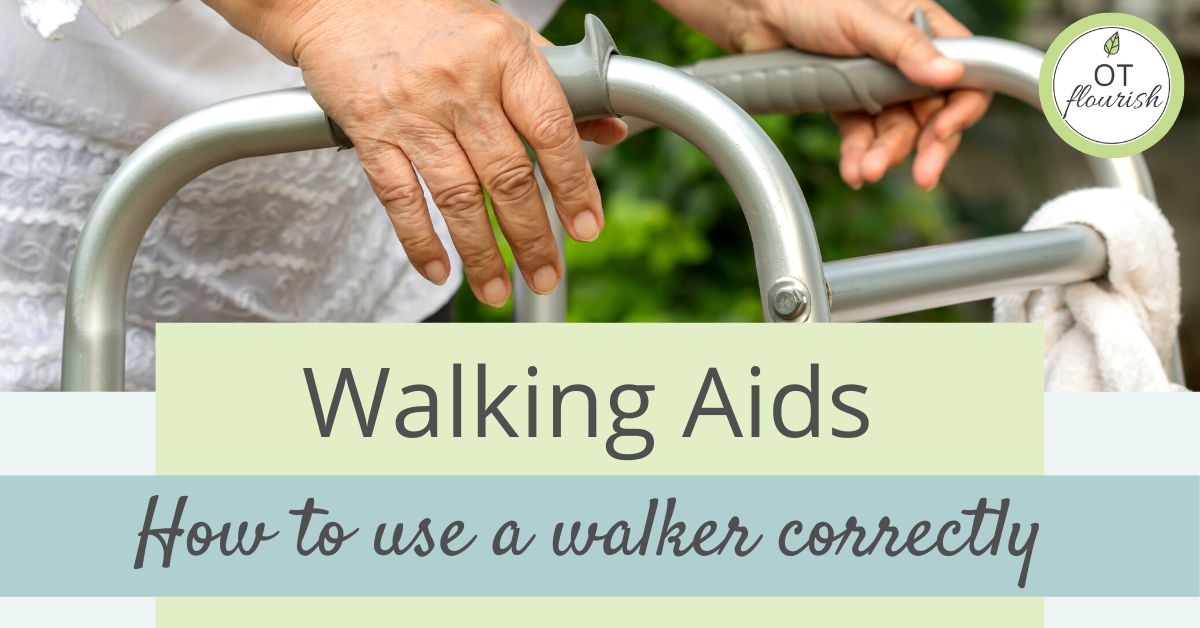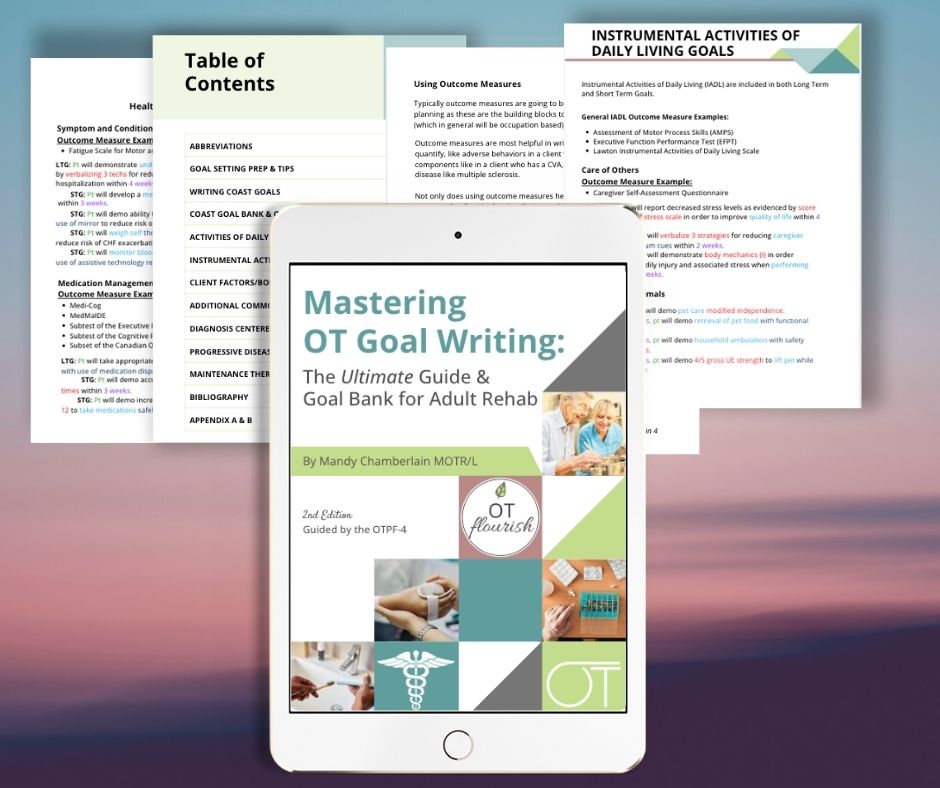So you’ve decided you (or a loved one) needs a walker – it’s a big step! Hopefully I can make the process easier by giving you some walker basics on how to use a walker.
I am going to walk you through on how to adjust your walker, how to correctly use it, the differences in a rollator versus a standard front-wheeled walker and which ones are the best. I also have a video from OT Flourish’s YouTube Channel at the end of this post demonstrating exactly what this all looks like.
How Tall Should a Walker Be?
An adjustable walker is definitely the way to go! There are a lot of resources that state that when you are standing up as tall as you can, try to keep a 20 degree bend in your elbow…but really…what does that even mean?
I like to do a quick height test. Stand up as straight as you can and place the walker right in front of you. Is the top of the walker at the height of your wrist? If not, it needs to be adjusted. If it is too high, hitting your forearm, lower it down. If it is too low, touching your fingers, raise it up.
All four legs of the walker should be the same height – so when you look at the number on the leg of the walker, they should all be the same.
It should be comfortable so you are not bending down to reach it or have your shoulders up toward your ears because it is too tall.
By adjusting it to your wrist level, it brings the height to the recommended 20 degree bend in the elbow, but without measuring or cracking out your 10th grade geometry!
What’s the Best Way to Walk with a Walker?
Remember: Your walker is like your best friend – you want to keep it close; it is your partner-in-crime; it is your support; you never want it to be alone…
First and foremost, all four wheels need to be touching the ground before moving and you need to stay inside the walker. Meaning, when you are actually walking with the walker, your hips should be in-line with the walker legs closest to you. It shouldn’t look like you are pushing the walker in front of you or the front of the walker is so close to you that you can’t take a decent step forward.
Your belly should be facing the front of the walker at all times. If you want to turn, you need to keep the walker in front of you and take small steps to turn versus doing a crazy twisty turn with the walker while you are holding it in the air!
A walker is meant to be there if you start to fall or lose your balance, so you need to keep it close.
What’s the Difference Between a Front Wheeled Walker and a Rollator?
Basically, a standard front wheeled walker has two wheels on the front legs and two straight legs on the back. It is the kind of walker most people are familiar with and the most stable of the two.
A rollator is a fancy walker of many names… “The Cadillac,” “4-Wheeled Walker,” “Rolling Walker,” “3-Wheeled Walker,” “The Fancy Kind of Walker,” or even “Bernie” (which was the name given to one of my patient’s walkers!). Most of these walkers have four wheels, a seat and brakes that you push down to lock when standing up or sitting down. They work best for people that need a little bit of stability or someone that needs rest breaks, like people with lung conditions, low endurance or easily short of breath.
The type of walker you use is best determined by a physical therapist who can determine which is safest for you based on your balance, how much weight you can put through your legs and arms, strength safety and endurance.
Video on How to Use a Walker
What do I Look for in a Walker?
I always recommend a standard walker with 5″ wheels on the front and “skids” (or also called “glides”) on the back legs. Sometimes walkers come with skids when you buy them and other times, you have to purchase them separately. They make the walker easier to push and they eliminate need to lift it while you are walking.
I know some people use tennis balls, which do work great, but you will definitely have to replace them, so I would recommend buying skids right from the get-go. 🙂
Standard walkers are 32″ to 40″ high and great for people between 5’5″ – 6’6″. They are typically 25″-29″ wide so take the width into consideration if you have narrow doorways or halls. There are narrower walker that are typically 22″-24″ wide but you have to specifically look for those if you need it.
Quick tip: To give more clearance using a walker through narrow doorways, trade the two front wheels so the wheels are on the inside of the walker. This makes the overall width of the walker smaller without compromising safety.
Also, if you are short, make sure you buy a junior sized walker. They are typically between 25.4″-32.4″ high and for people 4’10” – 5’5″. This way, you will be able to lower the walker to a safe and comfortable height.
Bariatric walkers are wider and have a weight capacity up to 500 lbs.
If you have arthritis, limited movement or weak hands, make sure you look for a trigger release walker. In general, a regular walker with easy 2 push button release works great, but I find over time, they get more difficult to push and the trigger release style seems to stand the test of time!
Bottom line: Having a good fitting walker helps keep you from falling, hurting yourself and enables you to stay as independent as possible.
There are lots of fun options out there to both display your personality and have a practical walker that will help you prevent falls!
Here are a couple of my favorite standard walkers:
Trigger Release Folding Walker – This standard walker has a different type of fold mechanism. It lets you fold it without letting go of the walker, PLUS it is easier for people with arthritis or painful hands.
Folding Walker with 5″ Wheels – This walker is basic, but checks all the boxes for a dependable walker – has built handles, rear skids, is adjustable and 2 buttons for quick fold up.
Here are a couple of my favorite rollator walkers:
Drive Medical Rollator – I like the curved back support for when you need to sit and zippered pocket for extra privacy of personal items when out and about.
Favorite Rollator Accessories:
Rollator Walker Seat and Backrest Covers – These are so fun! If you are not afraid to show your personality, these rollator covers come in so many colors and styles that you could have one for every mood and season.
Rollator Walker Tray – Gives a little extra support to plates of food and drinks when using the walker to get it to the table (be sure it fits your brand/style of walker!).
Comment Below: Why are some people so resistive to using a walker?
Interested in purchasing some of the items OT Flourish loves? If you click on any of the above links and make a purchase, it doesn’t cost you anything extra and a small portion of the sale helps support this site. I really appreciate it.






7 thoughts on “Walking Aids: How to Use a Walker Correctly”
We all need all the info we can get about med. equip.
definitely! glad it was helpful!
This was very helpful thank you for the information. I don’t know the types of walker out there to help with several of my issues in the need of a walker. Never knew I could acquire a walker that can help with my arthritis in my hands plus loading and unloading into my vehicle with being able to fold the walker while holding on to it. Thank very much
Thank you for your tutorial. It will be helpful in helping my friend to see your visual explanation.
glad it was helpful!
The back legs of my walker costantly drag along the ground. How can I cure that?
Hi! Actually the back legs of the walker are supposed to drag on the ground. What might help if you are finding that they are sticking, is to get some walker skids, like this: https://amzn.to/4eBTOrq